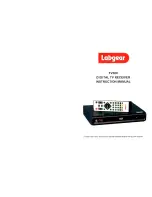
Example: Co-ordinates of Daun/Germany
Deg. latitude
50
°
11
‘
(
45
“)
N
Deg. longitude
06°
50‘
(10‘‘)
E
Converting the degrees latitude (DL):
DL
=
50
+
11/60
DL
=
50
+
0,2
(rounded)
DL
=
50,2
In the menu used for entering the geographical latitude, enter the value rounded to one
decimal place (50.2).
The decimal value of the degrees longitude is calculated in the same way.
10.3 Setting a satellite position
For each satellite position to be added, consecutively work through Points 10.3.1 to 10.3.3.
When programming satellite positions, we recommend you start with the satellite that has the
most Easterly orbital position. Continue by adding the other satellites, working your way
through in a Westerly direction, until you have reached the satellite with the most Westerly
orbital position. Your digital receiver is pre-programmed at the factory for the most popular
satellite positions. In addition, you can configure user-defined satellite positions (User 1 to
User 13) for any orbital position desired.
10.3.1 Selecting a satellite position
10.3.1.1 Selecting a pre-programmed satellite position
>
To add a satellite position to the satellite list, use the
arrow keys
to mark the field
Sat new
.
>
Confirm by pressing
OK
.
A list of the available satellite positions will be displayed.
>
Now use the
arrow keys up/down
to mark a satellite position you wish to add to
the satellite list.
>
Press the
OK
key to accept the selection.
If the
Geo-positioning function
(Point 10.2) is switched on, the dish will now be
automatically rotated to the programmed satellite position. The rotating procedure will be
indicated by the blinking text display “
turn
”
If the
Geo-positioning function
is switched off, you must rotate the dish to the desired
satellite position manually (Point 10.3.2.2).
10.3.1.2 Setting a user-defined satellite position (User satellite)
>
To add a user satellite position to the satellite list, use the
arrow keys
to mark the
field
Sat new
.
>
Confirm by pressing
OK
.
A list of the available satellite positions will be displayed.
>
Now use the
arrow keys up/down
to mark a user satellite position (User 1 to User 13).
>
Accept the satellite position by pressing
OK
.
>
Using the
arrow keys
now mark the panel
LNB-config
. for the adjustment of
a Test-Transponder. In this menu, proceed as described in Point 6.4.3.4 to enter the
data of the test transponder as well as of the LNB used.
82
10











































